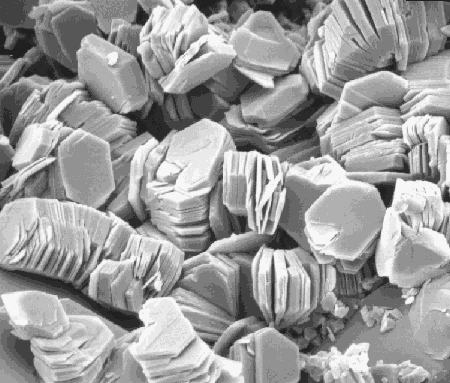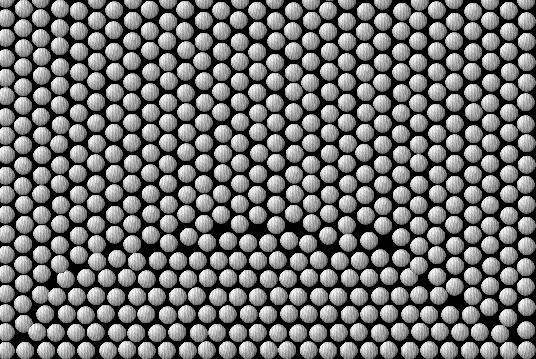

Crystals and informationCrystal information storageCrystal growth processes preserve aspects of their structure on macroscopic scales as they grow.They do this by using template-based copying processes, and error correction. You can see the results rather easily by looking at many common crystals. Quartz, Tourmaline and Emerald grow into long, relatively narrow crystals that tend to preserve their cross sectional area as they grow. Micas grow in thin sheets, that preserve information relating to their layer order and orientation as they grow. There are several different ways in which information can be stored in crystals:
1D information storage
This mode tends to arise when the tesselating shapes are long and thin - and tend to stick together well in two directions. Here information is stored in the pattern of layers. Note that the layers are not all the same - some are wider than others. Electron micrographs of the structure of (e.g.) [chlorite] shows a material with a preference for horizontal growth.
2D information storage
This mode tends to arise when the tesselating shapes are squat and fat - or otherwise tend to bond most strongly in one direction. Here information is stored in terms of the cross-sectional shape of the crystal. An electron micrographs of the structure of kaolinite should help illustrate the basic idea:
 [image from here] Such crystals look as though they have been extruded through a shaped template. In fact they have formed through crystal growth processes. Here is another micrographs of the structure of [kaolinite]. Information can also be stored in the pattern of faults within the crystal, by atom substitutions, and by other sorts of crystal defect. For example, here is a diagram of a simple dislocation fault:

Such faults tend to be preserved by crystal growth processes - since rectifying them is not favoured thermodynamically. Micrographs of the structure of (e.g.) [illite] show that these types of crystals can grow very long and thin. This mode of growth is of some interest - since the grooves in the surface of the clay can form enzymatic surfaces, by which the mineral can act to influence chemical reactions on its surface.
3D information storageSomewhat suprisingly 3D-information storage is logically possible in a self-replicating crystal structure. The required patterm combines the 1D and 2D growth patterns above - using a screw dislocation.
There are more details of the possibility for 3D genomes in an article entitled 3D Genes.
|